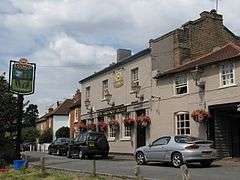Crooked Billet, Wimbledon
The Crooked Billet is a pub at 14–15 Crooked Billet, facing onto Wimbledon Common, Wimbledon, London. The building dates from the early 18th century and became the Crooked Billet during the 1750s.
| The Crooked Billet | |
|---|---|
 The Crooked Billet | |
 Crooked Billet  Crooked Billet | |
| General information | |
| Address | 14–15 Crooked Billet Wimbledon Common, Wimbledon, London |
| Town or city | London |
| Country | England |
| Coordinates | 51.421463°N 0.2278°W |
The district of Wimbledon called Crooked Billet may have taken its name from the pub.[2][3]
In 1888 Young's Brewery leased the Crooked Billet pub, and bought the freehold in 1928. In 1974 Young's Brewery purchased the Hand in Hand. After the pubs were enlarged and refurbished, they were sold in 2006.[4][5] The pubs are separated from the green. In Wright's Alley, Shire horses historically pulled brewer's drays delivering ale to customers."[2]
Both the pub and the area are well regarded.[6][7][8][9] Along with the Hand in Hand pub, it faces onto a small triangular green. Nearby can be found King's College School.[upper-alpha 1] Eagle House and Wimbledon House are also in the vicinity.[11]
The pub is said to be haunted by an Irish woman, but she only ever appears in the cellars.
There is a neighbouring pub, located just a few yards from the Crooked Billet, named the Hand in Hand.
References
Citations
- Matthews, Tony (6 January 2009). "Crooked Billet". London Gardens On Line. London Parks and Gardens Trust. Retrieved 7 January 2019.
...the first mention of a brewery and inn occurs in 1509 and the name was given to a small row of cottages, although 1776 is the first authenticated date of an alehouse here.
- Jane, Fred T. (April 1894). "The Romance of a London Omnibus". The English Illustrated Magazine, London (127): 691–699 – via ProQuest.(subscription required)
- Osbourne, Helen (November 1991). Inn and Around London: A History of Young's Pubs (1st ed.). London: Young & Co's Brewery. ISBN 0951816705.
- Whichelow, Clive (1998). Pubs of Wimbledon Village. Enigma Publishing. pp. 2, 15.
- "Food and Drink, London, 11 Best Pubs in London". The Resident. 1 July 2018. Retrieved 10 January 2019.
- Spranklen, Annabelle (30 June 2018). "Vogue's Insider Guide To Wimbledon". Vogue magazine. Retrieved 10 January 2019.
There’s more to Wimbledon than the two-week tennis tournament that takes over our screens every year. This leafy south west London district, with its famous SW19 postcode, is just 30 minutes outside of the city smog and a melting pot of hotspots worth a visit - including an idyllic stretch known as Wimbledon Village that borders the common. Here are seven little-known local secrets to make the most of while you’re visiting.
- Embley, Jochan (2 July 2018). "Wimbledon tennis: An SW19 area guide, from main attractions to nightlife". Evening Standard. Retrieved 10 January 2019.
Wimbledon is known for one thing above all: tennis. Every July, SW19 is transformed into a hub of activity as fans from all over the world arrive to watch the annual Championships. ... the south-west London neighbourhood is a relaxed, family-friendly area characterised by upmarket, leafy suburbs and green spaces. Its centre is packed with pubs, restaurants and coffee shops.
- Brennan, Ailis (2 July 2018). "Wimbledon Tennis in London: Where to Eat and drink". Evening Standard. Retrieved 10 January 2019.
If you’ve been inspired to get to grips with the grass but don’t feel quite like expending Grand Slam-level energy, then a recline on Wimbledon Common should do the trick. You’ll find the Crooked Billet on the corner of the green spot, and with the tennis on the TV, it’s the perfect spot for checking the scores over a Pimms.
- "Crooked Billet (also known as Shepherd's Hatch Gate". London Parks and Gardens Trust, parksandgardens.org. Retrieved 1 January 2019.
- Surrey Archaeological Society (1891). Surrey Archaeological Collections: Relating to the History and Antiquities of the County. 10. Bofworth & Sons. p. 160.